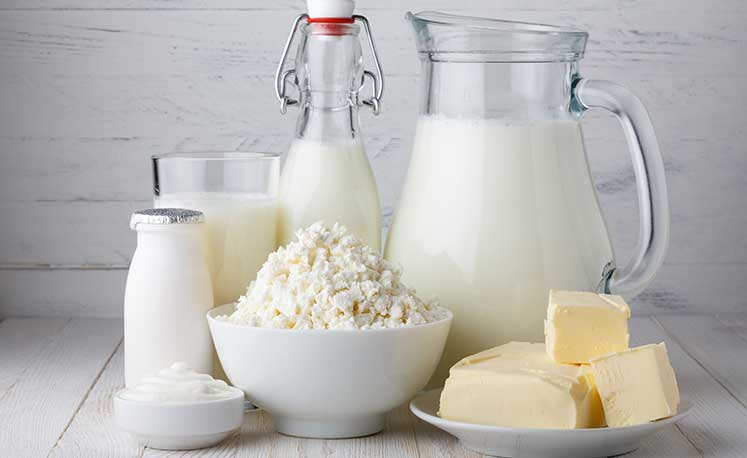From buttermilk to whey, learn more about dairy terms and ingredients.
Buttermilk – A cultured milk with a rich texture and tangy flavour. Available as low fat and whole milk buttermilk. Originally named for the milk left over after making butter. Buttermilk is cultured with mesophilic bacteria, which means the fermentation can occur at room temperature.
Casein – Casein is one of the proteins found in milk, and is the main protein in cheese. Casein is the component of milk that helps soothe the burning feeling you get when you eat very spicy food.
Cheese – Milk product formed when milk coagulates to form a curd. For fresh cheeses, the whey is drained from the curd and the curd may be seasoned with salt or herbs. Aged or ripened cheeses may be washed, salted, sprayed with cultures or otherwise treated to develop a flavour and texture unique to each type of cheese. Cheeses are classified as fresh, soft, semi-soft, firm, or hard. Fresh cheeses have the most moisture and hard cheeses have the least. Visit the Cheese Lover’s Reference Guide to learn more about how cheese is classified.
Chocolate milk – Usually made from partly skimmed milk to which cocoa and sugar are added. Small quantities of other ingredients may be added for taste and texture. Contains all the nutrients of the milk from which it is made.
Crème fraîche – A specialty product that may be prepared at home by mixing 250 mL of whipping cream with 5 mL of buttermilk. Heat the mixture to 30ºC. Let stand at room temperature until thickened. Refrigerate.
Cream – Separated from milk. Available as half-and-half or cereal cream, which usually contains 10% milk fat (M.F.); table or coffee cream, which usually contains 18% M.F; whipping cream which contains at least 32% M.F. Heavy cream is whipping cream with at least 36% M.F.
Evaporated milk – Canned milk that has over half (60%) of the water removed. When reconstituted it can be used in the same way as fresh milk. Available as whole, 2% and skim evaporated milk. The canning process gives it a slightly caramelized taste.
Homogenization – Process by which milk is forced through a fine mesh, which breaks the fat into such fine particles that they remain evenly dispersed throughout the milk. Without this process, cream rises to the top.
Kefir – A carbonated dairy food produced by the introduction of a combination of bacteria and yeasts. These are then allowed to ferment, producing a product which is bubbly and has a pungent, slightly sour taste. Kefir originates from the Caucasian Mountains, where it is a popular drink.
Lactaid® – Commercially derived lactase, available in liquid or powder form as well as tablets. Four to five drops liquid Lactaid® added to 1 liter of milk hydrolyzes 70% of lactose within 24 hours. Can be added to whole, skim, fresh, canned or reconstituted dry milk, cream or infant formula. Tablets can be taken immediately before eating high lactose foods or meals.
Lactase – Enzyme which splits the milk sugar, lactose, into its components: glucose and galactose.
Lactase deficiency – Refers to the normal, age-related, genetic decrease in lactase activity.
Lactose intolerance – The experience of gastrointestinal symptoms after the ingestion of lactose (either from milk or dairy products) or after a standard tolerance test. Symptoms include bloating, flatulence, abdominal pain and diarrhea.
Lactose maldigestion – Refers to the incomplete hydrolysis or breakdown of lactose in the small intestine, a consequence of low lactase activity. This is determined by a lactose tolerance test.
Lactose-reduced milk – Milk to which lactase enzyme has been added to break down the milk sugar, lactose. Tastes sweeter than regular milk, since the simple sugars resulting from the lactose reduction taste sweeter than lactose.
Microfiltered milk – Milk which has undergone a process of filtration that gives it a slightly creamier texture and somewhat longer shelf life.
Milk – Important source of calcium, protein riboflavin, vitamin A and vitamin D. Also contains about 87% water, carbohydrate and many other nutrients. Available as:
whole milk (contains about 3.25% fat by weight or about 9 grams per 250 mL),
2% milk (contains 2% fat by weight or about 5 grams per 250 mL),
1% milk (contains 1% fat by weight or about 3 grams per 250 mL) and
skim milk (contains virtually no fat).
NOTE: The low-fat milks and skim milk contain similar quantities of all the nutrients of whole milk other than being lower in fat.
Dairy products such as yogurt, cheese and buttermilk are usually made from unfortified milk. If made from unfortified milk, these products will contain the nutrients found in milk except vitamin D.
Pasteurization – Process by which the pathogens (disease-causing organisms) are destroyed. Milk is heated to 72º C (163º F) and held for 16 seconds, then cooled rapidly and refrigerated. Pasteurization may also be accomplished by heating milk to 63º C (145º F), holding it at this temperature for 30 minutes and then cooling quickly and refrigerating.
Processed cheese products –
- Processed cheese: made from cheese that has been ground, emulsified, melted and formed into slices.
- Processed cheese food: contains at least 51% cheese plus other dairy ingredients such as skim milk powder or whey powder.
- Processed cheese spread: contains at least 51% cheese plus other dairy ingredients and has a higher moisture content to allow easy spreading.
Rennet – Enzyme found in the stomach lining of cows that speeds up coagulation of milk during cheesemaking. Coagulating enzyme, a vegetarian alternative, is frequently used instead of rennet.
Skim milk powder – Starts as pasteurized skim milk. It is then partly evaporated and spray-dried into small particles. “Instant” skim milk powder has an additional step—it is blown into a steam chamber, then redried. The larger particles formed dissolve easily in water. Both vitamin A and D are added. When reconstituted, the nutrient value is equivalent to fluid skim milk.
Sweetened condensed milk – Milk that has been condensed to one-third its original volume and to which sugar has been added. Not a substitute for evaporated milk.
UHT milk – Milk which has been sterilized and packaged to exclude all microorganisms.
Whey – The liquid that separates from milk solids when milk coagulates. Contains lactose and minerals.



